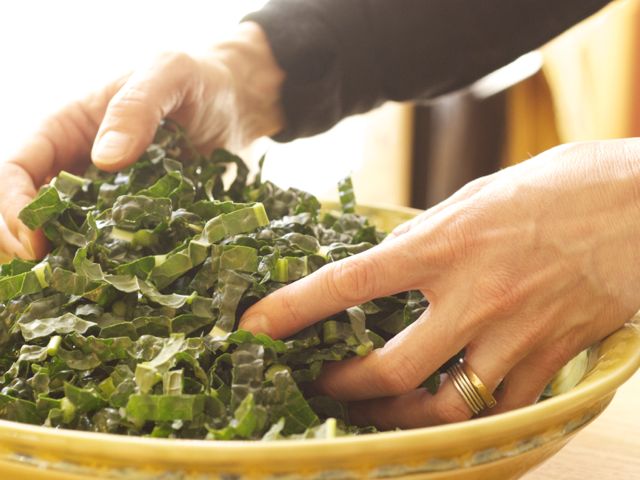
reference-image, l
(article, Erika Szymanski)
[%pageBreakSettings nobreak=true][%adInjectionSettings noInject=true] Sure, some people are so over kale already. (Bacon, too.) But kale (like bacon) is incredibly versatile. Which makes me believe that the hardy green is well on its way to becoming a staple in our diets. I agree that kale chips are fun, and kale-stuffed lasagne makes for a nice change. And I'll always throw a handful into soups. But kale salad is my core dish. I can whip up a big bowl after the farmer's market on Saturday and have portions of yummy nourishment for nearly the whole week. [[block(sidebar). h1.Featured recipe]] For me, kale salad is what pizza or pasta are for some cooks: a vehicle for creativity, experimentation, and using up leftovers from the fridge. Anything worth doing in the kitchen is worth trying in at least a few different incarnations, and kale salad is an especially friendly canvas; you don't have to fuss about cooking times (there are none), and nearly anything goes. [%image reference-image float=right width=400 caption="Sprinkle the sliced kale with salt, and massage the leaves to tenderize them."]As with most recipes, the keys to a good kale salad are balance and contrast. Flavor-wise, you want to aim for a combo of something pungent and salty (such as Parmesan or miso), and something sweet (such as apples or honey). Texture-wise, you'll want something with a bit of crunch to contrast with the tender chewiness of kale. Toasted nuts, seeds, or breadcrumbs, or another raw vegetable or fruit (quartered radishes, slivers of bell pepper, slices of cucumber, halved fresh snap peas, slices of firm persimmon) fit the crunchy bill nicely. (I find chunks of carrot a bit too dense for this purpose, but shreds are good for color and sweetness.) Sometimes I'll eat a big plate of kale salad as a meal, but for something a little more robust and suited to dinner, I'll add cooked and drained garbanzo beans, leftover cold chicken, chilled cooked shrimp, five-spice tofu, strips of pre-cooked tempeh, or quartered hard-boiled eggs. Prep school: Wash and dry the kale (mostly dry is fine), then slice the leaves into thin ribbons across the width of the leaf. (If you find the center stems too tough, slice them vertically out of the leaves before chiffonading the leaves horizontally. I like the stems, so I leave them in.) Sprinkle the ribbons with salt, and massage the leaves — get in there with your hands and squish around as though you're making meatballs — to tenderize the leaf structure; this step is well worth the effort, as it makes for much less ruminant-like chewing later. Add your other ingredients, dress the whole salad, and store (barring the addition of any super-perishable ingredients like fresh shrimp) in the refrigerator for up to five days. The following suggestions are more ideas than recipes — starting points for your own curly-edged green freewheelings. An Oregon fall version with hazelnuts, blue cheese, and pears? Leftover French lentils with steamed carrots and balsamic vinegar? There's a kale salad for every season. [[list(culinate8). #(clear n1). The Pan-Asian. This is probably my favorite incarnation of kale salad, with cubes of daikon radish, fresh bean sprouts, and rehydrated hijiki (a seaweed sold dried and easily found in Asian markets and many grocery stores). To dress, combine white or barley miso, Thai fish sauce, sesame seeds, and toasted sesame oil. Try five-spice tofu for more protein. #(clear n2). The Creamy Thai. Slices of red-bell pepper and peanuts for crunch, cubes of pineapple for sweetness, and big leaves of fresh basil and cilantro if you have them. Dress with silken tofu (the kind that comes in a shelf-stable box) puréed with almond butter, lime juice, Thai fish sauce, and a little red curry paste if you like the extra heat. Try adding shrimp. #(clear n3). The Pungent Chinese. This is the version for which I most often get outright cravings. Chopped preserved cabbage (get the Chinese kind, called tianjin,_ that comes in little earthenware jars), sliced cucumber, fermented black beans, and red chile flakes. Dress with a sprinkle of rice-wine vinegar and a little peanut oil, and try with baked tofu. #(clear n4). The California Vegan. This version was inspired by my favorite memories of California in the 1990s. Use cubes of apple for crunch, plus shredded carrots, thinly sliced avocado, sunflower seeds, and raisins. Dress with a squeeze of lemon juice, a drizzle of olive oil, and a sprinkle of sea salt. Especially good with garbanzo beans. #(clear n5). The Antipasto. Black olives, sun-dried tomatoes, sliced mushrooms, feta, pepperoncini (if you like them), and any fresh herbs you have around, dressed simply with a squeeze of lemon and good extra-virgin olive oil. You can also add salami and garbanzo beans. #(clear n6). The German. Sliced dill pickles and celery for crunch, cubed beets (if you don't have leftover roasted beets, try microwaving them), and quartered hard-boiled eggs. To dress, combine grainy mustard, apple-cider vinegar, dried tarragon, and olive oil. #(clear n7). The 1950s Diner. If classic diners knew about kale salad, that is. Sliced radishes, canned tuna, chopped green olives, and alfalfa sprouts. Dress with mayo (or plain Greek yogurt) whisked with a little apple-cider vinegar, honey, dried dill, poppy seeds, and a neutral olive oil. #(clear n8). The Thanksgiving Leftover. A combo of cranberries, pecans, and chunks of roasted squash, dressed lightly with apple-cider vinegar and olive oil. It's an obvious vehicle for leftover chicken or turkey. ]] p(bio). Originally from the Pacific Northwest, Erika Szymanski is currently earning a Ph.D. in New Zealand on how research gets communicated in the wine industry. She blogs at Wineoscope.

reference-image, l